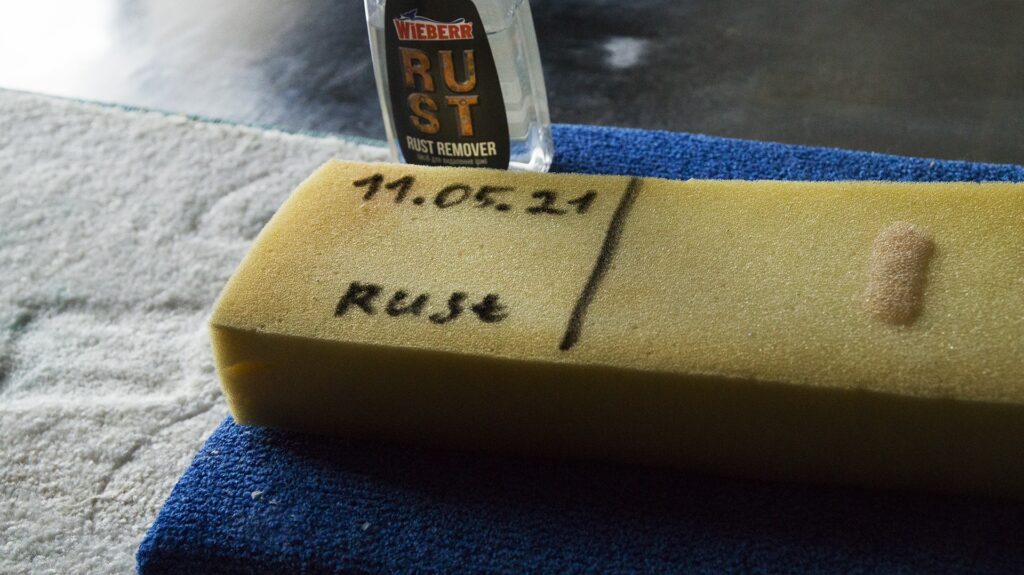Rust spots on upholstery and carpets are rare. But when they have already appeared, it may cause a problem. Ordinary stain removers do not remove such stains, most of them are not real Rust remover and just simply do not have the function of “removing rust stains”.
As a result, both household consumers and some “professionals” use whatever they can think of. I will not list everything, this is not the purpose of this article, but I will mention one glaring case: in one of the chats for communication between specialists in the cleaning of upholstered furniture and carpets, a story somehow flashed about removing rust from the sofa upholstery with a toilet cleaner.
Why this approach is harmful to furniture and how to remove rust from upholstered furniture correctly, I will tell you in this article below.
A little about the science of materials.
To begin with, stain remover usually interacts with the upholstery and the filler immediately below it.
Filler for upholstered furniture.
The most common filler for upholstered furniture is a polyurethane foam (EPPU) or, in common people, foam rubber. This material is afraid of strong oxidants more than anything else. I think that everyone saw the insides of the old sofa, the foam rubber in which turned into a brown, easily crumbling mass. Such a change in foam rubber is the result of oxidation with atmospheric oxygen.
The oxidation of foam rubber with atmospheric oxygen is uneven, sunlight and some chemicals (pollution or detergent residues) accelerate it, acting as catalysts for the oxidation reaction. Intense mechanical action also accelerates this process, because with each compression and straightening, air penetrates a little deeper than into foam rubber, which does not experience dynamic loads.
Foam rubber is present in most sofas, armchairs, upholstered chairs and, as a rule, is located directly under the upholstery fabric or separated from it by a thin layer of a rough spunbond cover or a layer of comfort from synthetic winterizer. Therefore, stain removers for cleaning furniture almost always “reach” the foam rubber.
Upholstery of a furniture
The variety of upholstery is much more than the variety of fillings. Most of the upholstery is made of 100% polyester, a material with the highest chemical resistance. But the textile industry does not live by polyester alone, and in the upholstery there are fibers of different types:
- polyamides;
- polyolefins;
- polyacrylates;
- polysaccharides – cellulose fibers (cotton, viscose) and fibers containing, along with cellulose, lignin (flax);
- protein fibers.
These fibers have different chemical resistance – some are resistant, like polyester, while others are much more susceptible to aggressive substances. Moreover, the susceptibility, as a rule, is selective – some are more susceptible to acids, others to alkalis.
If we again resort to “everyday” examples, one can easily recall the weakening of cotton fiber by chlorine-containing products. I think all the hostesses and owners faced this problem.
Removing rust stains usind Rust Remover
As mentioned, removing rust stains is a tricky task. To solve it, non-specialized tools are often used. In the case mentioned above, even a plumbing agent was used.
Such “jokes” can go unnoticed right away, however, they will almost certainly affect the life of the furniture due to the fact that some of the materials will be damaged by aggressive chemicals intended for completely different goals.
So, unsuitable chemicals, especially those containing unsuitable acids, can lead to deterioration of the polyurethane. The process can be so rapid that the swelling of the polymer will occur immediately, literally in a few seconds, but it can also have a delayed character, and in this place the polymer will simply disintegrate faster.
To illustrate what the EPPU looks like after applying the wrong chemistry, we made a special test, the results of which can be seen in the photo below. On the left is the area treated with the correct Rust Remover, on the right is another “stain remover”:

The same applies to the fibers of the upholstery – some of them can “burn” both from inappropriate chemicals and from improper application technology.
How to eliminate rust properly? How to remove a rust stain? How Rust Remover helps to remove rust stain safely and effectively?
The answer to these questions lies in two dimensions: the right technology and the right chemistry.
Removal of rust stains should begin with as complete mechanical removal of the build-up as possible on the surface. To do this, you need brushes, spatulas of suitable hardness – they break up a dense accumulation of rust, and the resulting powder is simply collected with a vacuum cleaner. Further, if the remainder of the rust powder is large, the treatment area can be washed with any cleaning solution containing surfactants. This solution will wash away most of the fine particles that have not adhered to the fiber. After that, a slight residue of rust will remain, which already needs to be treated with specialized chemistry.
It is advisable to dry the surface before using a special stain remover. When applied, the solution with a good and effective composition can be seen right away.
Rust removers are always caustic. The question is how much, and towards which materials it is more and less aggressive. Therefore, you should always rinse off the used stain remover, and, as a rule, this should be done with alkaline solutions, usually with simple textile cleaners.
We offer an effective Rust Remover
Actually, to solve such a problem we have the necessary chemistry – a special stain remover Rust Remover.
For carpet washing shops we offer it in 1 liter packaging. For a mobile dry cleaner – in bottles of 250 ml, because it is difficult and inconvenient to carry a large bottle with you around, and a small bottle can easily fit into a set for on-site cleaning.






